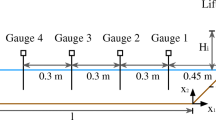Abstract
Two dimensional tsunami waves induced by submerged or aerial/sub-aerial rigid slider with and without sudden stop are simulated in time domain by using fully-nonlinear NWT (numerical wave tank) technique. Special attentions are paid on the maximum free-surface depression/rise and the resultant run-up near shoreline to assess relevant potential hazard. The fully-nonlinear results are compared with linear results. The free-surface deformation and run-up increase with mass height and sliding velocity and the growth rate can be better predicted by using the nonlinear simulation. The cases with or without sudden stop are next compared. The maximum free-surface rise/fall as well as shoreline run-up significantly increases in the case of sudden stop due to additional transient waves generated by the impact-like change of motion. The aerial/sub-aerial cases are also compared with submerged/underwater cases. Through a series of parametric investigations, it is clearly seen that the potential tsunami risk of aerial/sub-aerial land slide is much higher than that of submerged underwater land slide.
Similar content being viewed by others
References
Abadie, S., Morichon, D., Grilli, S.T., and Glockner, S. (2007). “VOF/Navier-Stokes numerical modeling of surface waves generated by subaerial landslides.” La Houille Blanche (in press).
Descriptive Model of the July 17, 1998 Papua New Guinea Tsunami http://walrus.wr.usgs.gov/tsunami/PNG.html
Enet, F., Grilli, S.T., and Watts, P. (2003). “Laboratory experiments for tsunami generated by underwater landslides: comparison with numerical modeling.” Proc. of the 13th Offshore and Polar Engrg. Conf, ISOPE03, Honolulu, Hawaii, Vol. 3, pp. 372–379.
Grilli, S.T., Vogelmann, S., and Watts, P. (2002). “Development of a 3D numerical wave tank for modeling tsunami generation by underwater landslides.” Engineering Analysis with Boundary Elements, Vol. 26, No. 4, pp. 301–313.
Grilli, S.T. and Watts, P. (1999). “Modeling of waves generated by a moving submerged body: Applications to underwater landslides.” Engineering Analysis with Boundary Elements, Vol. 23, pp. 645–656.
Grilli, S.T. and Watts, P. (2005) “Tsunami generation by submarine mass failure. I: Modeling, Experimental validation and sensitivity analyses.” J. Waterway, Port, Coastal, and Ocean Eng., Vol. 131, No. 6, pp. 283–297.
Halmark, H.L. (1973). “A note on tsunamis: their generation and propagation in an ocean of uniform depth.” J Fluid Mech, Vol. 60, pp. 769–799.
Heinrich, P.H. (1992). “Nonlinear water waves generated by submarine and aerial landslides.” J. Waterways, Port Coastal and Ocean Engng, Vol. 118, No. 3, pp. 249–266.
Koo, W.C., Kim, M.H., and Tavassoli, A. (2004). “Fully Nonlinear Wave-Body Interactions with Fully Submerged Dual Cylinders.” Int. Journal of Offshore and Polar Engineering, Vol. 14, No. 3, pp. 210–217.
Koo, W.C. and Kim, M.H. (2004). “Freely floating-body simulation by a 2D fully nonlinear numerical wave tank.” Ocean Engineering, Vol. 31, pp. 2011–2046.
Koo, W.C. and Kim, M.H. (2006). “Numerical simulation of nonlinear wave and force generated by a wedge-shape wave maker.” Ocean Engineering, Vol. 33, No. 8, pp. 983–1006.
Koo, W.C. and Kim, M.H. (2007a). “Fully nonlinear wave-body interactions with surface-piercing bodies.” Ocean Engineering, Vol. 34, No. 7, pp. 1000–1012.
Koo, W.C. and Kim, M.H. (2007b). “Long wave induced by a sub-sea landslide using a 2D numerical wave tank.” Journal of Ocean Engineering and Technology, Vol. 21, No. 5, pp. 1–8.
Liu, P.L-P., Wu, T.R., Raichlen, F., Synolakis C.E., and Borrero J.C. (2005). “Runup and rundown generated by three-dimensional sliding masses.” J. Fluid Mech., Vol. 536, pp. 107–144.
Lynett, P. and Liu, PL-P. (2002). “A numerical study of submarine-landslide-generated waves and run-up.” Proc. Royal Society A, Vol. 458, pp. 2885–2910.
Lynett, P. and Liu, PL-P. (2005). “A numerical study of the run-up generated by three-dimensional landslides.” J. Geophysical. Research, Vol. 110, C03006, doi:10.1029/2004JC002443.
Mei, C.C. (1983). “The applied dynamics of ocean surface waves.” Wiley-Interscience.
Monaghan, J.J. and Kos, A. (2000). “Scott Russell’s wave generator.” Physics of Fluids, Vol. 12, No. 3, pp. 622–630.
Panizzo, A., De Girolamo, P., and Petaccia, A. (2005). “Forecasting impulse waves generated by subaerial landslides.” J. Geophysical Res., Vol. 110, C12025, doi:10.1029/2004JC002778, 2005.
Tanizawa, K. (1995). “A nonlinear simulation method of 3-D body motions in waves (1st Report).” J Soc Nav Arch in Japan, Vol. 178, pp. 179–191.
Walder, J.S., Watts, P., Sorensen, O.E., and Janssen, K. (2001). “Tsunami generated by subaerial mass flows.” J. Geophysical Res., Vol. 108(B5), pp. 2236.
Watts, P., Grilli, S.T., Tappin D., and Fryer, G.J. (2005). “Tsunami generation by submarine mass failure Part II: Predictive Equations and case studies.” J. Waterway Port Coastal and Ocean Engrng., Vol. 131, No. 6, pp. 298–310.
Author information
Authors and Affiliations
Corresponding author
Rights and permissions
About this article
Cite this article
Koo, W., Kim, MH. Numerical modeling and analysis of waves induced by submerged and aerial/sub-aerial landslides. KSCE J Civ Eng 12, 77–83 (2008). https://doi.org/10.1007/s12205-008-0077-1
Published:
Issue Date:
DOI: https://doi.org/10.1007/s12205-008-0077-1




